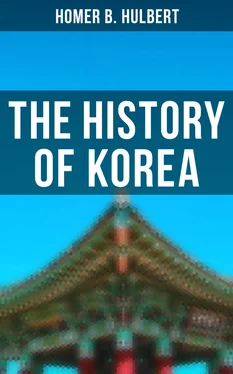
SILLA BOUNDARY STONE.
The last act in the tragedy of Ko-gu-ryŭ opens with the death of her iron chancellor, Hap So-mun. It was his genius that had kept the armies in the field; it was his faith in her ultimate victory that had kept the general courage up. When he was laid in his grave the only thing that Ko-gu-ryŭ had to fall back upon was the energy of despair. It was her misfortune that Hap So-mun left two sons each of whom possessed a full share of his father’s ferocity and impatience of restraint. Nam-săng, the elder, assumed his father’s position as Prime Minister, but while he was away in the country attending to some business, his brother, Nam-gŭn, seized his place. Nam-săng fled to the Yalu River and putting himself at the head of the Mal-gal and Kŭ-ran tribes went over with them to the Emperor’s side. Thus by Nam-gŭn’s treachery to his brother, Ko-gu-ryŭ was deprived of her one great ally, and gained an implacable enemy in Nam-săng. The Emperor made the latter Governor-general of Liao-tung and he began welding the wild tribes into an instrument for revenge. Then the Chinese forces appeared and together they went to the feast of death; and even as they were coming news reached them that the Ko-gu-ryŭ general, Yŭn Chŭn-t‘o, had surrendered to Sil-la and turned over to her twelve of Ko-gu-ryŭ’s border forts. It was not till the next year that the Chinese crossed the Liao and fell upon the Ko-gu-ryŭ outposts. The Chinese general had told his men that the strategic point was the fortress Sin-sŭng and that its capture meant the speedy capitulation of all the rest. Sin-sŭng was therefore besieged and the strugglebegan. The commandant was loyal and wished to defend it to the death but hismen thought otherwise, and they bound him and surrendered. Then sixteen other forts speedily followed the example.
Gen. Ko-gan hastened forward and engaged the Ko-gu-ryŭ forces at Keum-san and won a decided victory, while at the same time Gen. Sŭl-In gwi was reducing the fortresses of Nam-so, Mok-jŭ and Ch‘ang-am, after which he was joined by the Mal-gal forces under the renegade Nam-săng. Another Chinese general, Wŭn Man-gyŭng, now sent a boastful letter to the Ko-gu-ryŭ capital saying “Look out now for the defenses of that precious Am-nok River of yours.” The answer came grimly back “We will do so.” And they did it so well that not a Chinese soldier set foot on the hither side during that year. The Emperor was enraged at this seeming incompetence and banished the boastful general to Yong-nam. A message had already been sent to Sil-la ordering her to throw her army into Ko-gu-ryŭ and for the Chinese generals Yu In-wŭn and Kim In-t‘ă to meet them before P‘yŭng-yang. These two generals were in Păk-je at the time.
In 668 everything beyond the Yalu had fallen into the hands of the Chinese; even Pu-yŭ Fortress of ancient fame had been taken by Gen. Sŭl In-gwi. The Emperor sent a messenger asking “Can you take Ko-gu-ryŭ?” The answer went back “Yes, we must take her. Prophecy says that after 700 years Ko-gu-ryŭ shall fall and that eighty shall cause her overthrow. The 700 years have passed and now Gen. Yi Jök is eighty years old. He shall be the one to fulfill the prophecy.”
Terrible omens had been seen in the Ko-gu-ryŭ capital. Earthquakes had been felt; foxes had been seen running through the streets; the people were in a state of panic. The end of Ko-gu-ryŭ was manifestly near. So tradition says.
Nam-gŭn had sent 50,000 troops to succor Pu-yŭ Fortress but in the battle which ensued 30,000 of these were killed and the remainder were scattered. Conformably to China’s demands, Sil-la in the sixth moon threw her army into Ko-gu-ryŭ. The great Sil-la general, Kim Yu-sin was ill, and so Gen. Kim In-mun was in command with twenty-eight generals under him. While this army was making its way northward the Chinese under Gen. Yi Jök in the north took Tă-hăng Fortress and focussed all the troops in his command upon the defenses of the Yalu. These defenses were broken through, the river was crossed and the Chinese advanced 210 li toward the capital without opposition. One by one the Ko-gu-ryŭ forts surrendered and at last Gen. Kye-p‘il Ha-ryŭk arrived before the historic city of P‘yŭng-yang. Gen. Yi Jök arrived next and finally Gen. Kim In-mun appeared at the head of the Sil-la army.
After an uninteresting siege of a month the king sent out Gen. Chön Nam-san and ninety other nobles with a flag of truce and offered to surrender. But the chancellor Nam-gŭn knew what fate was in store for him, so he made a bold dash at the besieging army. The attempt failed and the miserable man put the sword to his own throat and expired. The aged general, Yi Jök, took the king and his two sons, Pong-nam, and Tong-nam, a number of the officials, many of Nam-gŭn’s relatives and a large company of the people of P‘yŭng-yang and carried them back to China, where he was received with evidences of the utmost favor by the Emperor. The whole number of captives in the triumphal return of Gen. Yi Jök is said to have been 20,000.
Ko-gu-ryŭ’s lease of life had been 705 years, from 37 B.C. to 668 A.D., during which time she had been governed by twenty-eighty kings.
Sil-la’s captives. … Ko-gu-ryŭ dismembered … extent of Sil-la … she deceives China … her encroachments … rebellion … the word Il-bon (Nippon) adopted. … Sil-la opposed China … but is humbled … again opposes. … Sil-la a military power … her policy … the Emperor nominates a rival king. … Sil-la pardoned by China … again makes trouble … the Emperor establishes two kingdoms in the north. … Sil-la’s northern capital … cremation … no mention of Arabs. … China’s interest in Korea wanes … redistribution of land … diacritical points … philological interest. … Pal-hă founded. … Chinese customs introduced. … Pal-hă’s rapid growth … omens. … Sil-la’s northern limit … casting of a bell … names of provinces changed. … Sil-la’s weakness … disorder … examinations. … Buddhisminterdicted … no evidence of Korean origin of Japanese Buddhism. … Japanese history before the 10th century … civil wars. … Ch‘oé Ch‘i-wŭn … tradition. … Queen Man’s profligacy.
Immediately upon the fall of Ko-gu-ryŭ the Sil-la forces retired to their own country carrying 7000 captives with them. The king gave his generals and the soldiers rich presents of silks and money.
China divided all Ko-gu-ryŭ into nine provinces in which there were forty-two large towns and over a hundred lesser ones of prefectural rank. In P‘yŭng-yang Gen. Sŭl In-gwi was stationed with a garrison of 20,000 men. The various provinces were governed partly by Chinese governors and partly by native prefects.
The king of Sil-la was now the only king in the peninsula and the presumption was that in view of his loyalty to the Chinese his kingdom would extendto the Yalu River if not beyond, but it probably was not extended at the time further than the middle of Whang-hă Province of to-day. The records say that in 669 the three kingdoms were all consolidated but it did not occur immediately. It is affirmed that the Chinese took 38,000 families from Ko-gu-ryŭ and colonized Kang-whe in China and that some were also sent to San-nam in western China. That Sil-la was expecting a large extension of territory is not explicitly stated but it is implied in the statement that when a Sil-la envoy went to the Chinese court the Emperor accused the king of wanting to possess himself of the whole peninsula, and threw the envoy into prison. At the same time he ordered Sil-la to send bow-makers to China to make bows that would shoot 1,000 paces. In due time these arrived but when the bows were made it was found that they would shoot but thirty paces. They gave as a reason for this that it was necessary to obtain the wood from Sil-la to make good bows. This was done and still the bows would shoot but sixty paces. The bow-makers declared that they did not know the reason unless it was because the wood had been hurt by being brought across the water. This was the beginning of an estrangement between the Emperor and the king of Sil-la which resulted in a state of actual war between the two.
Читать дальше










